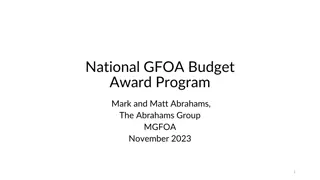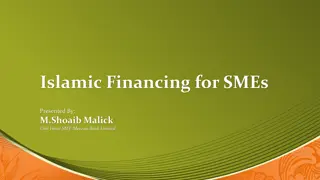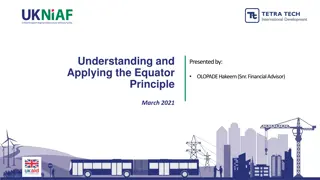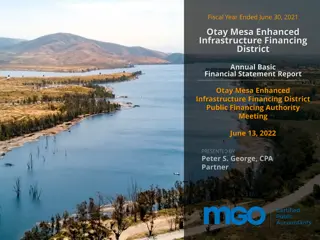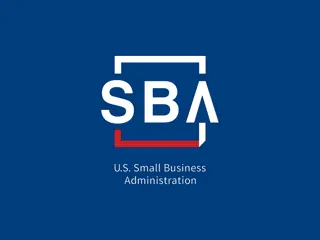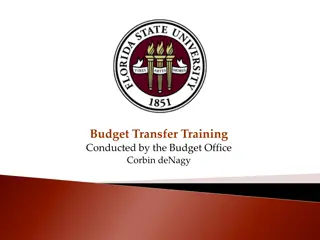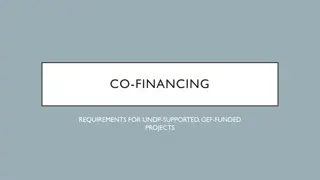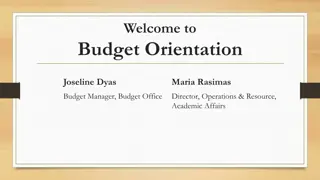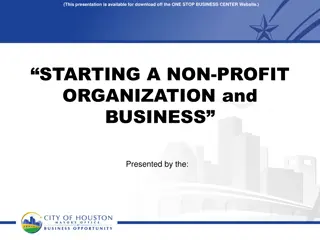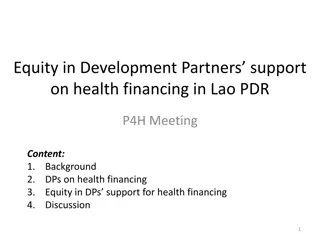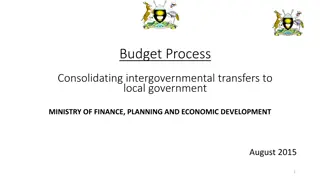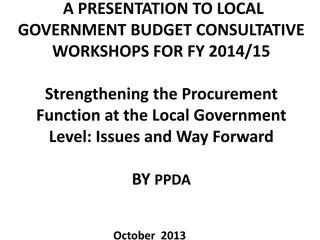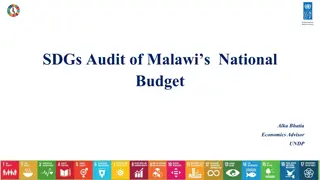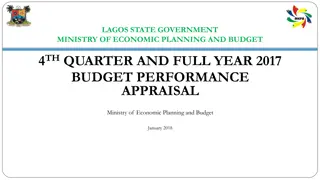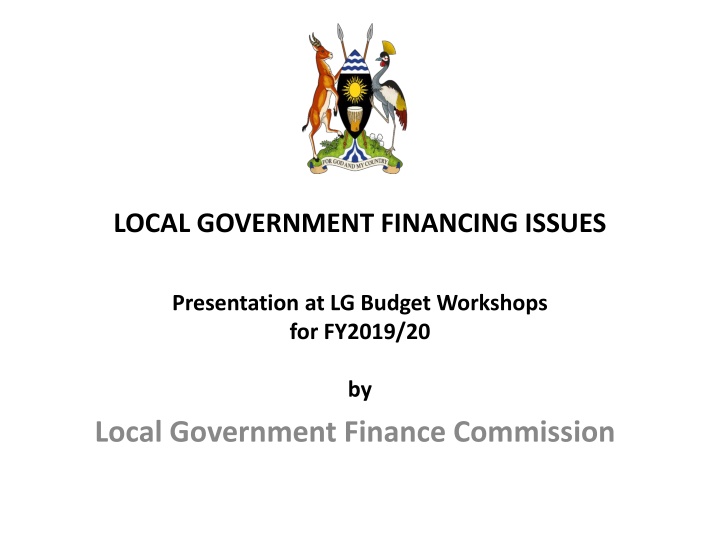
Local Government Financing Issues Presentation at LG Budget Workshops for FY2019/20
Explore the challenges and solutions discussed in the Local Government Finance Commission's presentation on financing issues at LG Budget Workshops for FY2019/20. Topics include responses to past issues, guidelines for grants, fiscal decentralization, local revenue enhancement, and more.
Download Presentation

Please find below an Image/Link to download the presentation.
The content on the website is provided AS IS for your information and personal use only. It may not be sold, licensed, or shared on other websites without obtaining consent from the author. If you encounter any issues during the download, it is possible that the publisher has removed the file from their server.
You are allowed to download the files provided on this website for personal or commercial use, subject to the condition that they are used lawfully. All files are the property of their respective owners.
The content on the website is provided AS IS for your information and personal use only. It may not be sold, licensed, or shared on other websites without obtaining consent from the author.
E N D
Presentation Transcript
LOCAL GOVERNMENT FINANCING ISSUES Presentation at LG Budget Workshops for FY2019/20 by Local Government Finance Commission
Presentation Outline 1. Responses to issues raised last year and how they have been addressed 2. Guidelines for Unconditional Grant 3. Fiscal Decentralisation Architecture (FDA) and Determining the Share of LG transfers out of the National Budget 4. Measures for Local Revenue Enhancement 2
Overview of the Issues and How they were addressed Issue Each LG must ensure that they cross-check for those numbers with UBOS in time & check on budget website: www.budget.go.ug/fiscal_transfersrather than communicating to us when it is too late to adjust the subsequent LG allocations. How addressed LGs have been complaining of late on wrong numbers for their population and area Designing of the Fiscal Decentralisation Architecture (FDA) And Determining LG share (grants transfers) out of the national budget were completed in Nov.2017. Discussions and reviews are still on to secure sustainable LG financing. Inadequacy of the Unconditional Grant Serious funding gaps at LGs 3
Overview of the Issues and How they were addressed Issue How addressed Establishing and Rolling out of the local revenue database for local revenue enhancement in all LGs. Poor Local Revenue performance The recommendation proposals for the Review of some relevant legislation on local revenue management are being considered by the Law Reform Commission. Some relevant legal provisions had several inadequacies The key ones include those on Local Service Tax, Local Government Hotel Tax, Property Rates, Trading licenses, Market dues, Royalties, Agency fees, Fish licenses and Departmental fees. LGFC with FINMAP support is in the process of hiring a consultant to design a framework for UNCONDITIONAL GRANT GUIDELINE setting rates and fees 4
Overview of the Issues and How they were addressed Issue How addressed Conflicting institutional roles, mandates, poor coordination and management of Fiscal Decentralisation etc FDA Design has been designed to address among others the issues of institutional roles and coordination to enhance orderliness in Fiscal Decentralisation. Dissemination of the same is in the process. 5
Overview of the 2019/20 Grant Information and Budget Requirements Policy priorities/sector objectives Structure and Purpose of Sector Transfers Allocation Formulae Budget Requirements 6
Policy Priorities A number of priorities were set out in the NDP to which the UCG is contributing, including: Strengthen Public Financial Management, through the introduction of the IFMS, Performance Based Budgeting and the reform of fiscal transfers. Increase public demand for accountability and strengthen compliance with accountability rules. Improve citizen participation and contribution in promoting rule of law, transparency and accountability in the provision of services to achieve equitable and sustainable development. Improve coordination, and harmonization of policy, planning, budgeting, and M&E at National and Local Government levels. Improve public service management, operational structures and systems for effective and efficient service delivery. Enhancing the performance of the public sector and strengthening service delivery. The Decentralisation of the Payroll, the Human Resources Function through the IPPS. 7
Structure and Purpose of the Unconditional Grant Grant District Unconditional Grant Purpose To fund the salaries of staff paid from the traditional Local Government payroll (i.e. all staff except teachers, health workers, agric-extension workers) in the HLG and LLGs Wage To fund both the recurrent and development costs of decentralised services alongside locally raised revenues in the higher Local Government and lower local governments Urban Unconditional Grant o/w Municipality government payroll (i.e. all staff except teachers, health workers, agricextension workers) in urban areas Council o/w Municipality decentralised services alongside locally raised revenues in urban areas Council o/w District o/w Sub- county Non Wage To fund the salaries of staff paid from the traditional local Wage o/w Town To fund both the recurrent and development costs Non Wage o/w Town 8
Structure and Purpose of PSM Transfers Grant Support Services Purpose To provide for pension and gratuity payments and arrears for former Local Government employees Transitional Development Ad hoc allocation to local governments for administrative activities. o/w Pension and Gratuity o/w Ad Hoc NB: These allocations are not formula based 9
Formula for Un-conditional Grant Wage Allocation The formula for UCG wage is in the process of being developed. The IPFs are based on the existing wage bill from MoPS plus approved recruitment by the Ministry of Public service. Variable District Municipal Town Council 100 Justification MoPS Wage Bill 100 100 Wage Bill Allocation from MoPS 10
Formula for Unconditional Grant Non- Wage Recurrent District Sub- county al 45 30 28 Number of sub- counties/Number of town councils Variable Municip Town Council 30 Justification Constant To ensure the basic costs of delivering administrative services in a local government can be met, whatever its size. Reflects the scale of beneficiaries for service delivery in local governments. To cater for the varying costs of delivering services in a local government, which are influenced by their geographical size and terrain and distance from Kampala. 10 10 Population (Rural/Urban) 40 70 60 70 Land Area (Hectares) 2 0 0 0 Population in Hard to reach and to stay areas 2 0 0 0 Distance From Kampala 1 0 2 0 UNCONDITIONAL GRANT GUIDELINE 11
Public Sector Management Grant Allocations under the Public Sector Management grant would remain ad hoc, and not formula based. The support services grant is currently comprised of: Pension and gratuity Urban Ad-hoc eg for start-up and related other Rural Ad-hoc eg for start-up and related other 12
Overview of Budget Requirements Area Narrative and performance contract Requirement The budget narrative summarises information on revenue, expenditure and key outputs in the performance contract. Total Workplan revenues and expenditures balance and are divided correctly between wage, non-wage recurrent, GoU and donor development. The revenues should also be divided correctly between higher and lower local governments Salaries of permanent staff must not exceed the overall staff and budget ceilings. Salaries must be funded from the unconditional wage grant. Salary allocations to administrative departments must be according to the filled posts within the approved structure, recruitment plan and salary scales. Overview of Revenues and Expenditure Salaries and related costs 13
Area Requirement The hard-to-reach allowance equivalent to 30% of a member of staff s salary must be provided for staff in the hard-to- reach areas outside town councils and HLG headquarters, in line with the Hard- to-Reach Framework and schedule designated by the Ministry of Public Service. Salaries and related costs 14
Overview of Budget Requirements Area Salaries and related costs (cont) Requirement Salaries, allowances and gratuity for elected leaders and members of statutory bodies must be budgeted for in full. Pension and gratuity (computed pension) for retired staff must be budgeted for in line with public sector management grant allocations. The Unconditional Non-Wage Recurrent Grant must be allocated to Lower Local Governments using the schedule that accompanies the IPFs for districts and municipalities. All allocations including pensions, allowances and gratuity, allocations for statutory functions should follow IPFs The allocation for the IPPS and IFMS should follow IPFs Lower Local Services Higher Local Services 15
Overview of Budget Requirements (cont.) Area Monitoring and Management Capacity Development Requirement A maximum of 5%of the non-wage recurrent budget can be used for monitoring and management of service delivery under the Administration Work plan. Capacity building activities should be consistent with the positive and negative lists. The development budget should fund administrative capital investments only. At most, 10% of budget allocations to construction and rehabilitation will finance investment service costs, such as bills of quantities or economic impact assessments. Local governments must not budget for activities specified in the negative list for capital investment. Development Investments 16
Inter-Governmental Fiscal Transfer Program for Results (UgIFT PfoR). When the allocation formulae was reviewed in 2015, some LGs experienced reductions in some grant allocations, effective FY2016/17. The effect seemed heavy especially for the sectors of Health and Education. Therefore this necessitated some additional funds most especially for the two sectors as this would otherwise mean closure of some service units like health units and schools in some LGs. In FY2018/19 Government negotiated financial support from World Bank to address the problem, in sector of Health and Education, under the Inter-Governmental Fiscal Transfer Program for Results (UgIFT PfoR). 17
Negotiations on Conditional Grants Article 193(3) of the Constitution requires negotiations between local governments and sector ministries managing conditional grant funded programs to take place with a view of coming up with a transparent and effective system of implementing programs funded using conditional grants. For FY 2019/20, the Commission conducted the negotiations in August 2018 and the results are included in the respective sector budget guidelines. 18
Design of the Fiscal Decentralization Architecture The design of the Fiscal Decentralization Architecture has been completed. This FDA has a number of recommendations, aimed at strengthening fiscal decentralization by protecting and promoting local government financing, enhancing orderliness and control in the management of intergovernmental strengthening LG capacity for supervision / monitoring of service delivery and increasing discretion in local decision making. fiscal relations, The design of the FDA focussed on achieving efficiency in fiscal decentralisation. The FDA has 6 pillars as reflected in the figure below. These are the legal and practical provisions that shall ensure orderly operation, protection, credibility and reliability of the fiscal decentralisation system. This constitutes the fourth phase of the current reforms in the Fiscal Decentralisation. 19
Determining LG Share out of National Budget This phase included, reviewing LG mandates and estimating the cost of adequately financing those mandates relative to the overall budget. This is to ensure that the size of grant transfers to LGs is commensurate with the range of services provided by the LG's which helps to improve confidence in budgets and sustain service delivery. Status: The Final Report was submitted in November 2017. 21
Some of the key recommendations Determining the Share of LG transfers out of the National budget: Over the medium term, LG transfers/ grants allocations should recover the real values from the per capita of UGX 69,858 in FY2017/18 to atleast UGX 115,757 per-capita over the medium term. That is, to nominally increase gradually from UGX 3.151trn (FY2018/19) to UGX 4.759trn (FY2021/22) over the next 4 years. Inter-Governmental Fiscal Transfers: Equity and transparency have to be regularly observed in the grants allocation formulae. Local revenues:Their legal provisions have to be reviewed. Besides, a Local Revenue Management Policy linked to National Tax Policy should be formulated for effective management of revenues. 22
Measures to enhance Local Revenue Performance Establishing and Rolling-out of the Local Revenue Database The Commission, with financial resources from FINMAPIII has between FY2014/15 and FY2017/18 supported 121 districts, 16 MCs and 4 TCs to computerise the local revenue registers. The above mentioned LGs were provided a laptop and a printer each, for enhancing local revenue database management. In addition, with financial support from Uganda Support to Municipal Infrastructure Development Programme (USMID) the Commission has assisted the 14 pilot Municipalities to increase their collections. 23
Impact of Local Revenue Databases As a result of multiple approaches including utilization of the local revenue database, local revenue collection has increased for many LGs. For instance between FY2012/13 and FY2016/17 the Districts like Jinja has increased from UGX 596m to 3.3bn; Ntungamo from UGX 289m to 1.315bn; Mbarara from UGX 535m to 1.45bn; Buikwe from UGX 719m to 1.34bn; Wakiso from UGX 1.94m to 2.7bn; Arua from UGX 503m to 1.23bn; Mukono from UGX 396m to 1.29bn; Mpigi from UGX 275m to 539m; And for the Municipal Councils like Jinja increased from UGX 3.5bn to 11bn; Lira increased from UGX 753m to 2.0bn; Mbarara from UGX 1.86bn to 5.4bn; Gulu from UGX 1.69bn to 3.3bn; Tororo from UGX 676m to 1.01bn; Masaka from UGX 836m to 4.7bn; Arua from UGX 1.08bn to 3.75bn; FortPortal from UGX 625m to 3.2bn; Moroto from UGX 200m to 665m; and Hoima from UGX 861 to 3.6bn, just to mention a few. 24
Challenges of Establishing LR Databases Some of the LGs which have been supported have not given the activity the attention it deserves; so they need to strategically provide support to the LLGs (in terms of political support and operational funds to collect and update data, assess the tax payers and sources e.t.c) and supervision follow-up. Many of these LGs receiving the support do not have appropriate equipment like computers and printers, yet they are very necessary and therefore should be included in the budgets for revenue enhancement. District and MCs are asked to support these LLGs. 25
The Way forward in FY 2018/19 and 2019/20. Further FDA dissemination workshops will be held for LGs, at regional levels in FY2018/19. FDA recommendations are scheduled to be discussed the key policy organs of the state. FDA recommendations shall be submitted to Cabinet, for approval into a Policy to Guide the management of LG financing. The Framework to guide in the setting of rates and fees for LGs, once completed, will be discussed with LGs. 26

